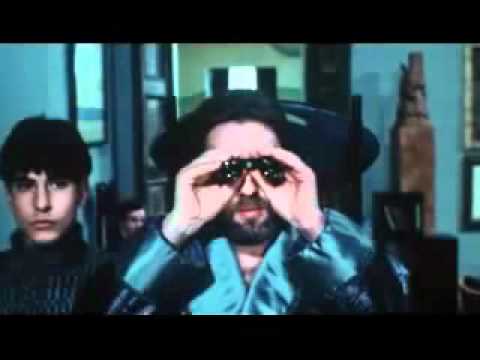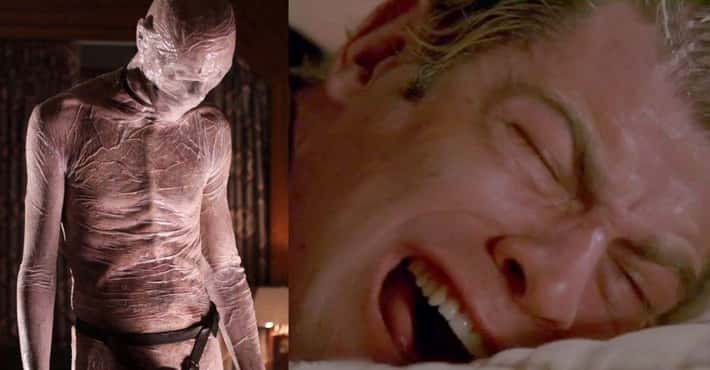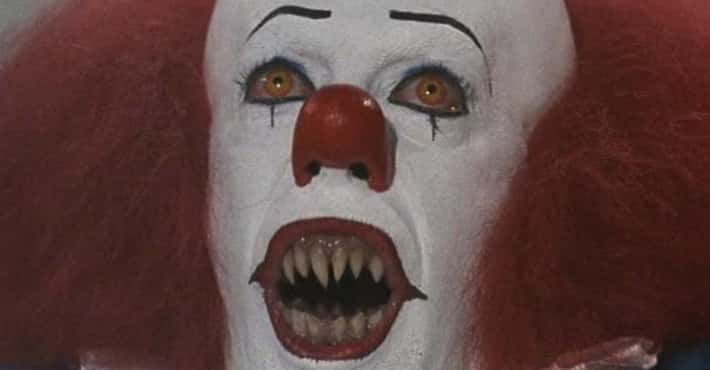The 35 Best Exploitation Films
 1Ruggero Deodato, Luca Barbareschi, Robert Kerman
1Ruggero Deodato, Luca Barbareschi, Robert KermanControversial even before its release, this groundbreaking 1980 Italian film directed by Ruggero Deodato is known for its realistic portrayal of violence, cannibalism, and graphic animal cruelty. The film utilizes a found footage narrative that centers on a documentary crew who go missing in the Amazon rainforest while investigating the existence of cannibal tribes; the recovered footage reveals the crew's own immoral actions and the gruesome consequences they face. Despite being heavily censored and banned in several countries, Cannibal Holocaust remains an influential work in horror cinema, popularizing both the found footage format and raising moral debates around the limits of realism in filmmaking.
More Cannibal Holocaust- #32 of 73 onThe 65+ Best Found Footage Movies
- #352 of 397 onThe Best Horror Movies Of All Time
- #35 of 36 on36 Movies That Were Ridiculously Banned Around the World
 2Pam Grier, Sid Haig, Anitra Ford
2Pam Grier, Sid Haig, Anitra FordDirected by Jack Hill in 1972, this women-in-prison film is notorious for its exploitative themes, violence, and uninhibited sexuality. Starring Pam Grier and Anitra Ford as inmates of a brutal jungle prison, the film delivers a relentless onslaught of sadistic guards, staged cat fights, and an eventual uproarious revolt against their captors. The Big Bird Cage not only solidified Grier's iconic status as a genre film star, but also pushed the boundaries of what was considered acceptable in cinema, leading to an influx of similarly themed movies in the 1970s.
 3Paolo Bonacelli, Caterina Boratto, Hélène Surgère
3Paolo Bonacelli, Caterina Boratto, Hélène SurgèreItalian director Pier Paolo Pasolini's last work before his mysterious murder, Salò is heavily based on the Marquis de Sade's novel, 120 Days of Sodom, and is set in the final days of Fascist Italy. The film chronicles the brutal and degrading sexual, mental, and physical torture inflicted upon young men and women by powerful libertines. With its deeply unsettling content and unwavering depiction of human depravity, Salò remains one of the most controversial and polarizing films in the history of cinema, pushing the limits of what could be shown on screen and sparking debates over censorship, artistic freedom, and the nature of storytelling.
- #11 of 125 onThe 100+ Grossest Movies Ever
- #99 of 133 onThe Most Utterly Depressing Movies Ever Made
- #2 of 19 onHorror Movies Nobody Who Is Squeamish Can Finish, Ranked
 4Christina Lindberg, Per-Axel Arosenius, Bo Arne Vibenius
4Christina Lindberg, Per-Axel Arosenius, Bo Arne VibeniusAn unforgettable Swedish revenge film from 1973, Thriller: A Cruel Picture (also known as They Call Her One Eye) tells the story of a young deaf-mute woman named Frigga who is kidnapped, mutilated, and forced into prostitution, ultimately seeking brutal vengeance on her captors. With its infamously gritty and explicit scenes of violence and sexual abuse, the film has earned a cult following and inspired the likes of Quentin Tarantino, who paid homage to its iconic eye-patched protagonist in his 2003 creation, Kill Bill. Though it was banned in several countries and heavily edited for release, the uncut version of the film stands as a testament to the extremes of exploitation cinema.
 5Janine Lindemulder, Ron Jeremy, Erik Estrada
5Janine Lindemulder, Ron Jeremy, Erik EstradaA staple of the women-in-prison subgenre, 1990's Caged Fury features a young woman wrongly incarcerated in a brutal detention facility, who must navigate the sadistic hierarchy of inmates and guards to survive. Filled with graphic violence, gratuitous nudity, and unexpected twists, the film plays on audiences' fears of confinement and powerlessness, while providing a sensationalized look at life behind bars. Caged Fury is emblematic of the late-era exploitation films that would continue to push boundaries and provide titillating entertainment throughout the 1990s.
 6Connie Mason, William Kerwin, Jeffrey Allen
6Connie Mason, William Kerwin, Jeffrey AllenHerschell Gordon Lewis, a pioneer of gore cinema, delivered this outrageous 1964 horror comedy that follows six unsuspecting Yankee tourists who are lured into a Southern town only to be brutally murdered in macabre ways during the town's centennial celebration. Blending dark humor with groundbreaking gore effects, Two Thousand Maniacs! shocked audiences upon its release, while also highlighting and satirizing the ongoing tensions between the North and the South in America. The film's enduring influence can be seen in later horror works, such as Rob Zombie's House of 1000 Corpses and Eli Roth's Hostel series.
 7Mel Ferrer, Robert Kerman, Franco Fantasia
7Mel Ferrer, Robert Kerman, Franco FantasiaDirected by Italian horror maestro Umberto Lenzi, this 1980 cannibal film follows a group of Western tourists who encounter an insane cult leader and vengeful cannibals deep within the jungles of New Guinea. Combining elements of adventure and horror, Eaten Alive! presents a shockingly graphic and visceral journey into a heart of darkness, escalating the onscreen brutality with each new atrocity. As one of the most controversial and infamous examples of the Italian cannibal subgenre, Eaten Alive! demonstrates the global reach of cinema and its ability to provoke both intrigue and revulsion.
 8Sid Haig, Bill Moseley, Sheri Moon Zombie
8Sid Haig, Bill Moseley, Sheri Moon ZombieIn 2005, musician-turned-director Rob Zombie created this horror-crime hybrid as a sequel to his debut feature, House of 1000 Corpses. Delving deeper into the deranged world of the murderous Firefly family, the film explores the twisted psyches of its anti-heroes, evoking sympathy and disgust in equal measure. The Devil's Rejects showcases Zombie's distinct stylistic sensibilities and fearlessness in confronting taboo subject matter, solidifying his place as a formidable voice in contemporary genre filmmaking.
 9Sid Haig, Bill Moseley, Sheri Moon Zombie
9Sid Haig, Bill Moseley, Sheri Moon ZombieRob Zombie burst onto the horror scene in 2003 with this shocking and surreal directorial debut. The film centers around a group of friends who stumble upon a rural house inhabited by the homicidal, sadistic Firefly family. With its twisted humor, excessive gore, and nightmarish visuals, House of 1000 Corpses is a love letter to exploitation cinema, showcasing Zombie's penchant for pushing the boundaries of onscreen debauchery and artistic expression.
 10Dave O'Brien, Dorothy Short, Lillian Miles
10Dave O'Brien, Dorothy Short, Lillian MilesOriginally released in 1936 as Tell Your Children, Reefer Madness has since become a cult favorite for its comically exaggerated portrayal of the supposed dangers of marijuana use. Following the descent of several high school students into crime, madness, and depravity due to their exposure to the drug, the film now serves as a fascinating time capsule of drug hysteria and misinformation in early twentieth-century America. Reefer Madness' lasting impact can be seen not only in the kitschy midnight screenings it enjoys today but also in the ongoing debate surrounding drug policy and cultural representation.
 11Betty Connell
11Betty ConnellHerschell Gordon Lewis, the "Godfather of Gore," ventured into the realm of biker films with this 1968 offering, which follows a group of tough, independent women as they wreak havoc on a small town. By focusing on female characters and subverting traditional gender roles, She-Devils on Wheels provided a unique perspective within the genre and broke new ground in its portrayal of women in cinema. As one of the earliest examples of the female-centric biker movie, the film has had a lasting impact on the genre and paved the way for future filmmakers to explore unconventional narratives and characterizations.
More She-Devils on Wheels- #39 of 71 onThe 70+ Best Motorcycle Movies
- #42 of 60 onThe Best Outlaw Biker Movies
- #15 of 20 onThe Best '60s Biker Movies, Ranked
- Ursula Andress, Stacy Keach, Franco Fantasia
Sergio Martino's 1978 Italian horror film takes audiences on a perilous journey as a woman searches for her missing husband in the uncharted jungles of New Guinea, only to encounter a tribe of cannibals who view her as a divine figure. Known for its explicit violence and real animal cruelty, The Mountain of the Cannibal God pushed boundaries in both content and production, garnering a significant amount of controversy upon its release. The film remains a polarizing entry in the annals of exploitation cinema, continuing to spark conversation about the ethical limits of filmmaking and storytelling.
 13
13Nude Nuns with Big Guns
Asun Ortega, Devanny Pinn, Tawny Amber YoungA 2010 Grindhouse homage by director Joseph Guzman, Nude Nuns with Big Guns has all the elements of classic cinema: a lurid title, gratuitous nudity, over-the-top violence, and a revenge-driven plot. Centered around Sister Sarah, a nun betrayed by her church and left for dead, the film follows her quest for bloody vengeance, as she dons a habit and wields an arsenal of firearms. With its tongue-in-cheek approach to the genre, Nude Nuns with Big Guns simultaneously pays tribute to and satirizes the outrageous films that inspired it.
 14Srdjan Todorovic, Sergej Trifunovic, Jelena Gavrilovic
14Srdjan Todorovic, Sergej Trifunovic, Jelena GavrilovicUnrelenting in its brutality and controversy, 2010's A Serbian Film, directed by Srđan Spasojević, takes the audience on a harrowing journey through the life of a retired porn star who is drawn back into the industry for one last disturbing project. The film's graphic depictions of sexual violence, incest, and murder have incited outrage and censorship worldwide, raising questions about the limits of artistic expression and the nature of shock value in filmmaking. Despite the backlash, A Serbian Film remains a testament to the enduring power of exploitation cinema to provoke, disturb, and push the boundaries of what can be committed to film.
More A Serbian Film- #3 of 125 onThe 100+ Grossest Movies Ever
- #1 of 22 on22 Disturbing, Brutal Movies Based on Real-Life Atrocities
- #11 of 88 onThe Most Awkward Movies to Watch with Your Parents
 15Andrew Lauer, Fred Vogel
15Andrew Lauer, Fred VogelIn 2001, Fred Vogel's grim, hyper-realistic found footage film shocked and repulsed audiences with its unflinching brutality and relentless pace. Chronicling the sadistic exploits of two serial killers who document their gruesome acts on home video, August Underground forces viewers to confront the darkest corners of human nature and grapple with the boundaries between reality and fiction. By pushing the limits of onscreen violence and narrative structure, the film has left an indelible mark on horror cinema and paved the way for a new generation of boundary-pushing filmmakers.
 16Phyllis Diller, Horace B. Carpenter, William Woods
16Phyllis Diller, Horace B. Carpenter, William WoodsDirected by William Lustig in 1934, Maniac centers around a psychologically damaged serial killer named Frank Zito, whose penchant for scalping his victims is rooted in childhood trauma. Shot on a shoestring budget and featuring gritty, realistic gore effects, the film gained notoriety for its uncompromising violence and disturbing psychological insights. Maniac's influence can be seen in the horror genre's continued fascination with human monsters and the exploration of the psyche behind horrific acts.
More Maniac- #90 of 115 onThe Goriest Horror Movies Ever Made (2023 Update)
- #51 of 51 onThe 50+ Best Movies In Public Domain
- #30 of 45 onThe 45 Best 1930s Horror Movies, Ranked
 17Bo Svenson, Fred Williamson, Ian Bannen
17Bo Svenson, Fred Williamson, Ian BannenLong before Quentin Tarantino's homage, Enzo G. Castellari's original 1978 war film followed a group of condemned soldiers on a daring mission behind enemy lines during World War II. Blending intense action sequences, cynical humor, and unapologetic violence, The Inglorious Bastards demonstrated the broad scope and versatility of exploitation cinema, proving that even traditional war films could push the envelope in terms of content and characterization. The film's impact on popular culture can be traced through its high-profile fans (including Tarantino) and its continued relevance as an example of genre filmmaking at its boldest.
- #161 of 375 onThe Best Movies Based On Books
- #159 of 364 onThe 300+ Best Action Movies Ever Made
- #49 of 58 onThe 55+ Best Movies Of 1978
 18Geoffrey Lewis, Lurene Tuttle, Aldo Ray
18Geoffrey Lewis, Lurene Tuttle, Aldo RayA chilling and controversial prison horror film from 1979, Human Experiments features a young woman sent to a maximum-security prison, where she becomes the subject of cruel psychological experiments under the guise of rehabilitation. With its exploitative elements, including shocking abuse and an oppressive atmosphere, the film delves into the dark world of human experimentation and the corruption of power. Human Experiments confronts its audience with difficult moral questions and has maintained its status as a provocative cult classic within exploitation cinema.
One of the earliest known feature-length exploitation films, 1933's This Nude World is part documentary and part sensationalist peek into the burgeoning nudist movement of the time. Through a series of staged scenarios and ethnographic observations, the film purports to expose the hidden world of nudist colonies, offering a titillating experience for curious viewers. This Nude World not only helped to establish the conventions and style of exploitation filmmaking, but also contributed to ongoing debates surrounding censorship, voyeurism, and societal norms.
 20Claudia Jennings, Alan Vint, Roberta Collins
20Claudia Jennings, Alan Vint, Roberta CollinsA prime example of the popular roller derby subgenre, 1972's Unholy Rollers stars Claudia Jennings as a young woman determined to rise through the ranks of the ruthless and competitive sport. With its raucous portrayal of life in the fast lane and unabashed sexuality, the film shatters expectations and challenges social conventions. Unholy Rollers' enduring influence can be seen in subsequent works exploring the world of roller derby, as well as its revitalization as a subversive and empowering sport for women.
- 21
I Escaped from Devil's Island
Jim Brown, Christopher George, James LuisiJim Brown and Christopher George star in this gritty 1973 action-adventure film about two inmates attempting to break free from the notoriously brutal French penal colony of Devil's Island. Directed by William Witney, the film delivers memorable performances, thrilling action sequences, and a palpable sense of desperation, capturing the experience of life in an inescapable prison. I Escaped from Devil's Island stands as a prime example of cinema's ability to deliver exciting and engrossing entertainment that pushes the envelope in terms of content and subject matter.
- 22
Little Miss Innocence
A daring and provocative film from 1973, Little Miss Innocence centers on two seemingly naïve teenagers who seduce and torment a middle-aged man in a twisted game of power and manipulation. Blurring the lines between innocence and depravity, the film challenges conventional notions of morality and sexual politics. Little Miss Innocence showcases cinema's daring willingness to push boundaries and explore taboo subjects, influencing future generations of filmmakers to delve into similarly uncomfortable territory.
 23Danny Trejo, Andrew Swant, Mark Metcalf
23Danny Trejo, Andrew Swant, Mark MetcalfIn this 2009 neo-grindhouse homage directed by Frankie Latina, audiences are thrust into a world of espionage, treachery, and revenge, as a disgraced CIA agent embarks on a mission to avenge the death of his wife. With its blend of action-packed set pieces, over-the-top characters, and stylish visuals, Modus Operandi demonstrates the lasting impact of cinema, even in a contemporary context. The film's throwback aesthetic and loving tribute to the genre serve as a reminder of the enduring appeal and influence of boundary-pushing cinema.
- 24
Crucified Girls of San Ramon
Vonetta McGee, Gordon Mitchell, William BergerThis shocking and hard-to-find Mexican horror film from 1971 tells the story of a man who is haunted by visions of young women being brutally crucified. Directed by Rafael Pérez Grovas, the film features several graphic and disturbing scenes, making it a sought-after item among exploitation enthusiasts. Crucified Girls of San Ramon remains a powerful testament to the endurance of exploitation cinema's provocative spirit, even in the face of censorship and controversy.
 25Lawrence Eugene Williams, Ray Sager, John Shackleford
25Lawrence Eugene Williams, Ray Sager, John ShacklefordHerschell Gordon Lewis returned to his exploitation roots with this 1968 film, which follows a group of nihilistic teenagers wreaking havoc on their small town. With its gleeful embrace of destruction, chaos, and youthful rebellion, Just for the Hell of It challenged conventional notions of morality and authority. The film's audacious spirit and uncompromising vision have made it an enduring cult favorite within exploitation cinema and laid the groundwork for future films exploring the darker side of youth culture.
- 26
Guinea Pig: Slaughter Special
Naoto Takenaka, Peter, 久本雅美A notorious entry in the Japanese Guinea Pig series, this 1988 collection of short films directed by Hideshi Hino presents an unrelenting barrage of gore and grotesqueries, from mutilations to monstrous deformities. Intended as an exercise in extreme horror and visceral reaction, the series has been both praised and reviled for its audaciousness and disregard for conventional cinematic norms. Guinea Pig: Slaughter Special exemplifies the relentless drive of filmmakers to push the limits of both taste and imagination, inspiring a host of imitators and genre enthusiasts along the way.
- 27
Stacey
Anne Randall, Anitra FordA cult classic from 1973, Stacey is notable for combining elements of detective noir and violent action in its portrayal of a no-nonsense female private investigator who gets caught up in a web of crime and conspiracy. With a strong female lead, stylized visuals, and a thrilling plot, the film exemplifies the genre's ability to challenge conventional storytelling and empower marginalized characters. Stacey's blend of action and social commentary has paved the way for future films that similarly blur the lines between exploitation and mainstream entertainment.
 28Ruth Warrick, Rhys Williams, William Tracy
28Ruth Warrick, Rhys Williams, William TracyIn this 1950 cautionary tale, audiences bear witness to the consequences of alcoholism as a once-promising pianist spirals into a life of despair and degradation. The film's explicit portrayal of addiction and moral decay was shocking for its time, offering a glimpse into a dark reality often hidden from polite society. One Too Many exemplifies the power of exploitation cinema to expose the uncomfortable truths about human nature and societal ills, often with a sensationalist and dramatic flair.
 29
29Schizophreniac: The Whore Mangler
John GiancasproA disturbing and graphic descent into madness, 1997's Schizophreniac: The Whore Mangler follows a severely disturbed man who targets and murders prostitutes in a series of brutal acts. With its over-the-top violence, explicit gore, and controversial themes, the film provides a visceral experience that challenges the boundaries of taste and acceptability. Schizophreniac: The Whore Mangler's unrelenting intensity remains a testament to the fearlessness and daring of filmmakers in their pursuit of extreme and provocative storytelling.
- Rosalind Cash, Casey Biggs, Vernee Watson-Johnson
This 1978 film delivers an unflinching and sometimes psychedelic look at the horrors of drug addiction, as a promising musician becomes ensnared in a downward spiral of substance abuse. By presenting a stark and unglamorous depiction of drug use and its consequences, Death Drug simultaneously entertains and educates its audience while pushing the boundaries of onscreen content. The film ultimately serves as a reminder of the potency and impact of cinema as a means of engaging with difficult and controversial subject matter.




























